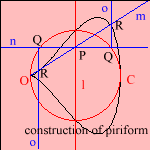
|
 |
 |
 |
 |
 |
 |
piriform |
quartic |


This curve has a form resembling a pear 1),
why it is also called pear-shaped quartic
or pear-shaped curve.
The first to study the curve was the French mathematician G. de Longchamps
(1886).
The curve is defined in a rather complex way, in the following steps:
- let there be a circle C with a point O on it
- let there be a line l, perpendicular to the diameter of the circle through O
- now, draw an arbitrary line m through O, crossing l in P
- draw a line n perpendicular to l through P, crossing C in points Q
- then, draw a line o parallel to l through Q

- now the curve is formed by the points R that are intersection of the lines o and the arbitrary line m
Could you follow me? If not, take a look at the picture.
In fact, the given formula is a (linear) generalization of the curve. The construction is
only valid for the curve when the constant 1 is replaced by the 2.
The piriform has as parameter equation: ![]()
The curve is also called the pegtop, it is easy to
see why.
In your throat there is a place where pieces of food can be stuck, e.g. a fish bone. This pit is called the piriform fossa 2).
The curve can be generalized to the teardrop curve.
1) Pirum (Lat.) = pear
2) Fossa (Lat.) = moat, pit.